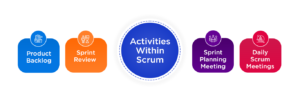Scrum, the most widely used agile methodology, is a core framework that makes it easier to approach and execute complicated work/products in the quickest and most efficient manner. Lets deep dive in How to Project Management with Scrum.
In the case of traditional waterfall development, there was a lot of extra work needed on weekends or evenings to finish it within the timeline that was determined in advance. It is challenging to stick to the schedule. But most of those problems can be resolved with Agile. Of course, depending on the needs of the project, there are benefits and drawbacks.
Roles in a scrum team
A Scrum team essentially consists of three roles, each with specific responsibilities and power. Development Team, Product Owner, and Scrum Master are the three positions.
Product Owner
The individual who bears the greatest responsibility for the project. A team member who communicates the demands and problems of customers and end users to the team(mostly to Scrum Master). Organize the backlog of projects for creating the system. In order for the members of the development team to grasp the description and purpose of features and requirements. It is critical to make sure that the Product Backlog items are consistently updated in order of priority.
The Scrum Master or Development Team is in charge of estimating (time, cost, etc.) costs, resources), dependencies, and technical work items. The Product Owner is ultimately responsible for prioritizing and updating backlog items.
Scrum Master
Scrum as a methodology is simple to describe, but it can be challenging to implement successfully. As a result, there is a job called Scrum Master, which supports and directs the team to ensure that the Scrum axis is never off. Create strategies for implementing Product Backlog items and assisting in problem-solving.
Development Team
Basically, the group that creates the system from scratch. As opposed to the traditional waterfall process, you may also be responsible for tasks like business analysis, design, cloud construction, and testing in addition to development when appropriate.
When implementing a project in Scrum, the following qualities are crucial:
Sprint: A brief period during which software is developed (usually two weeks)
Project Tasks or Items: These are kept in a ranked list known as the product backlog (all listed in management tools, etc.)
Goal: Determine during the sprint, what needs to be completed from high-priority projects.
Sprint assessment: A person known as the product owner opens the meeting after each sprint concludes, assesses, and adds tasks.
During frequent short intervals known as sprints, Scrum implements features from the highest priority product backlog items and evaluates the already implemented features. As a result, we have made it feasible to create products that are market and development-ready swiftly. This benefit has been a key factor in the growth of Scrum.
Activities within scrum

Product backlog definition, sprint planning meetings, daily scrums, sprint reviews, and sprint retrospectives are all examples of scrum activities.
Product Backlog
A gathering to review and specify items in the product backlog, while articulating their precise specifications and deadlines (DOD). After you have a solid definition understanding, development team can concentrate on your development work.
Sprint Planning Meeting
A meeting is held at the start of a sprint. Provide a list of the features that will be implemented during this sprint along with a plan for doing so (with the sprint goal). The backlog will be updated by the product owner, and the team will execute it as necessary.
Daily Scrum Meetings
Essentially, this is a meeting between the development team and the scrum master. Where development team will discuss regarding:
- What we have accomplished since the previous daily scrum
- What is the next item to work upon
- Consult if there are any issues.
Sprint Review
A meeting is held after sprint completion. Agenda includes:
- Demo the features implemented
- GO or NO-GO for the features
- Examine whether renewal is required.
Sprint Retrospective
The meeting that followed the Sprint Review. The discussion includes what was able to do in this sprint. Next, choose what can be improved for the subsequent sprint.
Scrum values that make it the most efficient
Openness: Most of the time job done is perfect. But if something is missed or issues were observed, the speaker who committed the error must speak politely, and the person who corrected it must also speak politely.
Respect: Ensuring that team members’ voices are heard through listening to them. If you refrain from providing negative feedback, the project will be safer.
Concentration: You have a better chance of achieving the sprint goal if you concentrate on and implement the Product Backlog items during the sprint. The best plan is the following plan. Let’s concentrate on the job at hand.
Commitment: Everyone on the team is dedicated to producing the best product they can. In order for Scrum to be successful, the business must be totally dedicated to the project, appreciate the team’s dedication to the sprint’s objectives, and adhere to its principles.
We at Odiware are experts in doing Project Management with Scrum, if you would like to have an expert consulting team to manage your project effectively talk to us.




